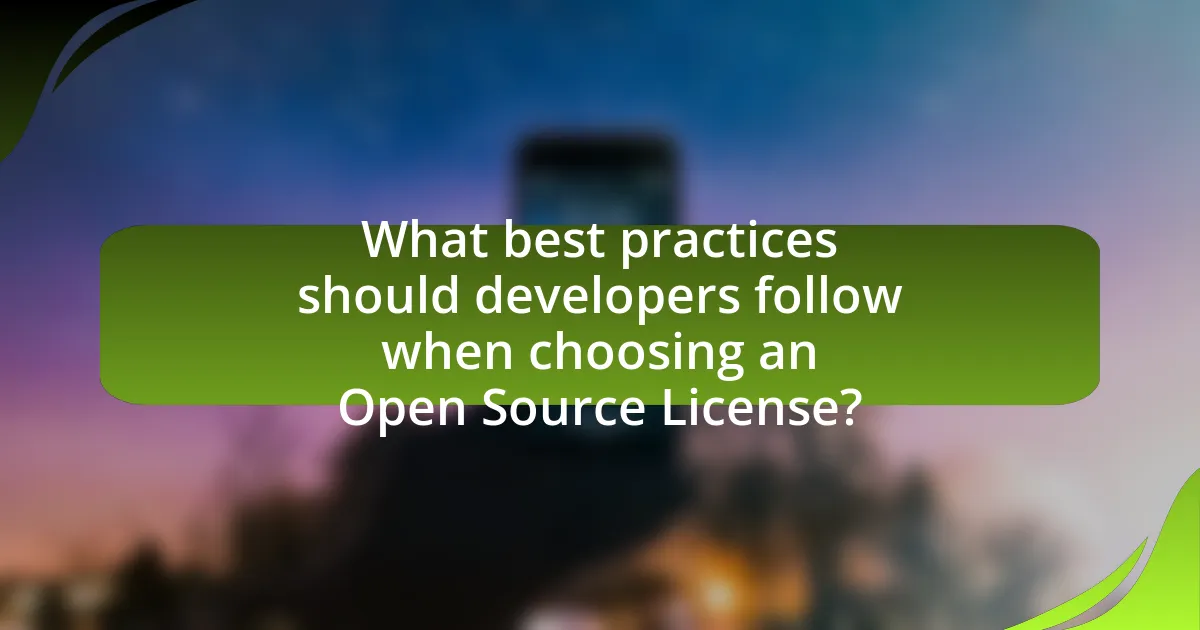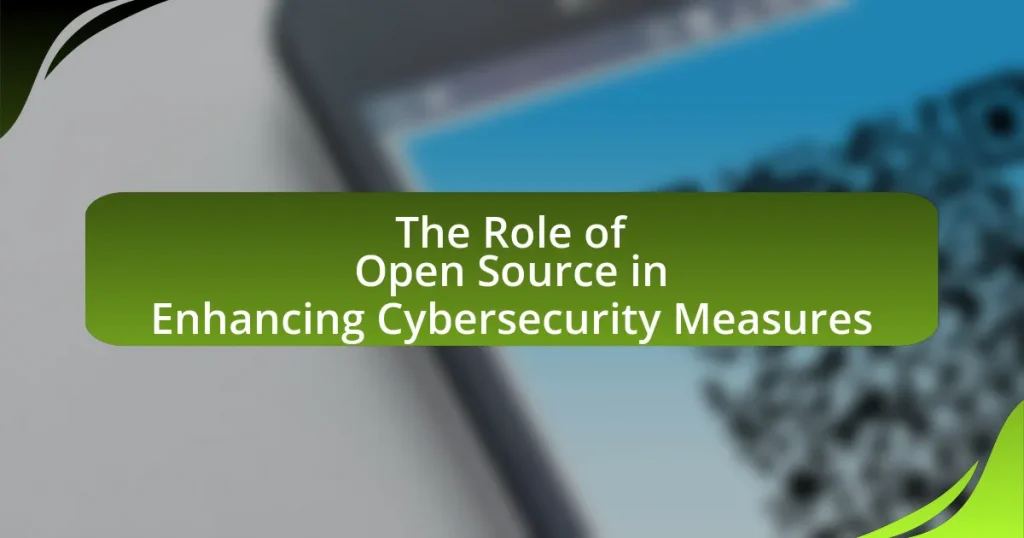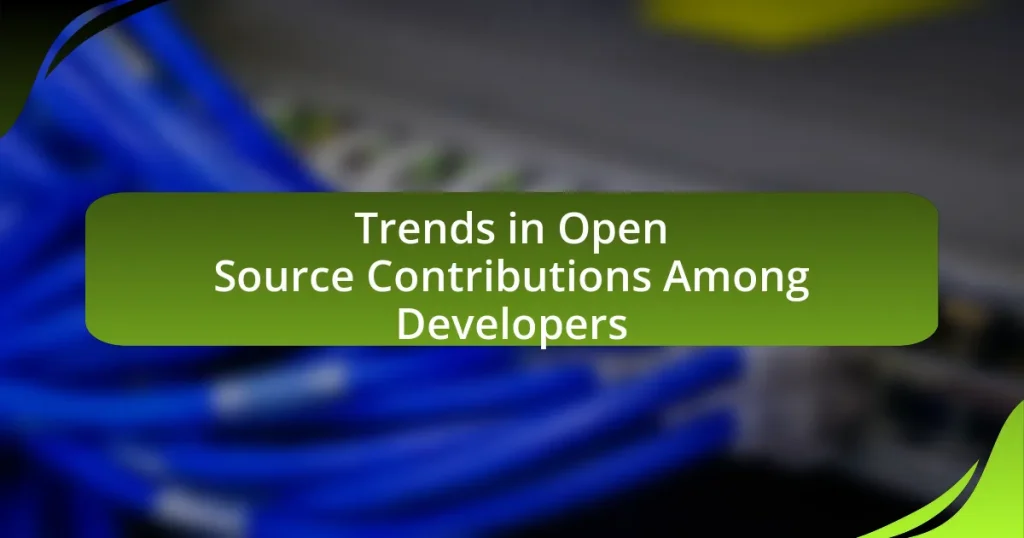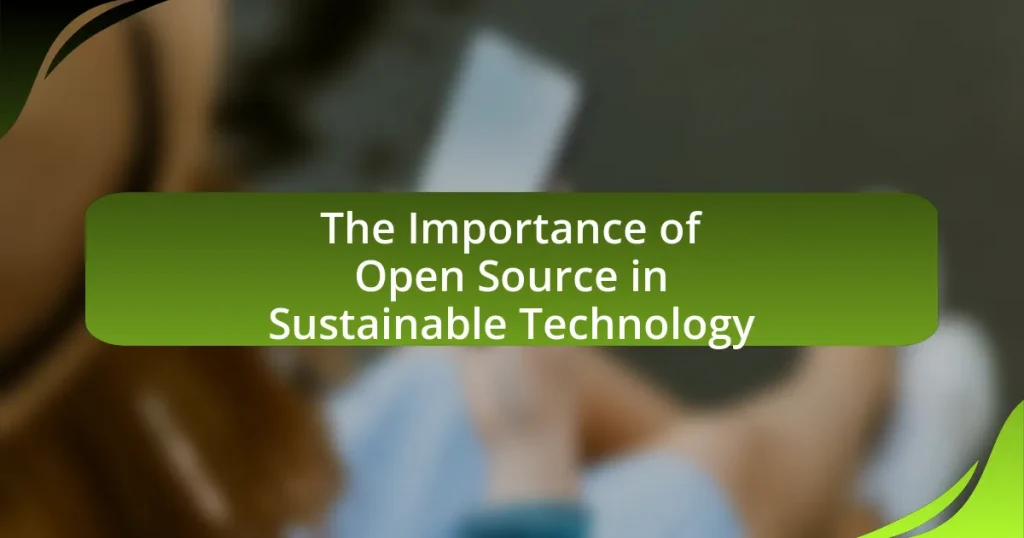Open source licensing is a legal framework that enables the free use, modification, and distribution of software, fostering collaboration and innovation within the software development community. This article explores the various types of open source licenses, including permissive and copyleft licenses, and their key components such as permissions, conditions, and limitations. It emphasizes the importance of selecting the appropriate license for developers, detailing best practices for compliance, communication, and community engagement. Additionally, the article addresses common mistakes developers make regarding licensing and provides practical tips for maintaining compliance and effectively managing dependencies.

What is Open Source Licensing?
Open source licensing is a legal framework that allows software to be freely used, modified, and distributed by anyone. These licenses ensure that the source code is accessible to users, promoting collaboration and innovation within the software development community. Notable examples of open source licenses include the GNU General Public License (GPL) and the MIT License, which outline specific terms regarding usage, modification, and redistribution. According to the Open Source Initiative, there are over 80 approved licenses, each with unique conditions that govern how software can be utilized, ensuring compliance with the principles of open source software.
How does Open Source Licensing function?
Open source licensing functions by allowing developers to use, modify, and distribute software under specific terms set by the license. These licenses define the rights and obligations of users, ensuring that the software remains open and accessible while protecting the original creator’s interests. For example, licenses like the GNU General Public License (GPL) require that any derivative works also be open source, thereby promoting collaboration and sharing within the community. The legal framework established by these licenses is crucial for fostering innovation and ensuring compliance with the terms of use.
What are the key components of Open Source Licensing?
The key components of Open Source Licensing include permissions, conditions, and limitations. Permissions define what users can do with the software, such as using, modifying, and distributing it. Conditions impose requirements on users, such as attributing the original authors or sharing modifications under the same license. Limitations specify restrictions, such as liability disclaimers or prohibitions on using the software for certain purposes. These components ensure that the software remains open and accessible while protecting the rights of the original creators and users.
How do these components influence software distribution?
Open source licensing components significantly influence software distribution by determining the terms under which software can be used, modified, and shared. These licenses, such as the GNU General Public License (GPL) and the MIT License, establish legal frameworks that dictate how developers and users can interact with the software. For instance, the GPL requires that any derivative works also be open source, thereby promoting a culture of sharing and collaboration, while the MIT License allows for more permissive use, enabling broader adoption in proprietary software. This legal clarity affects distribution strategies, as developers must choose licenses that align with their goals for collaboration, commercialization, and community engagement.
What are the different types of Open Source Licenses?
The different types of Open Source Licenses include permissive licenses, copyleft licenses, and public domain licenses. Permissive licenses, such as the MIT License and Apache License, allow users to modify and distribute the software with minimal restrictions. Copyleft licenses, like the GNU General Public License (GPL), require that any modified versions of the software also be open source. Public domain licenses, such as the Unlicense, allow software to be freely used, modified, and distributed without any restrictions. These classifications help developers choose the appropriate license based on their goals for software distribution and collaboration.
What are the characteristics of permissive licenses?
Permissive licenses are characterized by their allowance for users to modify, distribute, and use the software with minimal restrictions. These licenses typically do not require derivative works to be open-sourced, enabling greater flexibility for developers and organizations. For example, the MIT License and the Apache License permit proprietary use, allowing companies to incorporate open-source code into proprietary software without the obligation to disclose their source code. This promotes wider adoption and collaboration while maintaining the original author’s rights.
How do copyleft licenses differ from permissive licenses?
Copyleft licenses require derivative works to be distributed under the same license terms, ensuring that the freedoms granted by the original work are preserved in all modified versions. In contrast, permissive licenses allow derivative works to be distributed under different terms, including proprietary licenses, which can restrict the freedoms of the original work. For example, the GNU General Public License (GPL) exemplifies a copyleft license, while the MIT License serves as a prominent example of a permissive license. This fundamental difference shapes how software can be reused and modified, influencing the development and distribution practices within the open-source community.
Why is Open Source Licensing important for developers?
Open Source Licensing is important for developers because it provides legal protection and clarity regarding the use, modification, and distribution of software. This legal framework ensures that developers can share their work while retaining certain rights, which fosters collaboration and innovation within the software community. For instance, licenses like the GNU General Public License (GPL) require that derivative works also remain open source, promoting a culture of sharing and continuous improvement. Additionally, open source licenses can enhance a developer’s reputation and credibility, as projects under recognized licenses are often more trusted by users and contributors.
How does Open Source Licensing protect developers’ rights?
Open Source Licensing protects developers’ rights by granting them control over how their software is used, modified, and distributed. These licenses, such as the GNU General Public License and the MIT License, explicitly outline the permissions and restrictions associated with the software, ensuring that developers retain ownership of their intellectual property while allowing others to use it under specified conditions. For instance, the GNU General Public License requires that any derivative works also be open source, thereby preserving the original developer’s intent and contributions. This legal framework not only safeguards developers from unauthorized use but also fosters a collaborative environment where they can benefit from community contributions while maintaining their rights.
What role does Open Source Licensing play in community collaboration?
Open Source Licensing plays a crucial role in community collaboration by establishing clear legal frameworks that govern the use, modification, and distribution of software. These licenses, such as the GNU General Public License and the MIT License, enable developers to share their work openly while protecting their rights and the rights of users. By defining how software can be used and modified, open source licenses foster an environment of trust and cooperation among developers, encouraging contributions and collaboration. For instance, a study by the Open Source Initiative found that projects with permissive licenses attract more contributors, demonstrating that clear licensing can enhance community engagement and collaboration.

What best practices should developers follow when choosing an Open Source License?
Developers should carefully evaluate the goals of their project and the implications of various Open Source Licenses before making a choice. Understanding the differences between licenses, such as permissive licenses like MIT and restrictive licenses like GPL, is crucial as it affects how others can use, modify, and distribute the software. Additionally, developers should consider the compatibility of the chosen license with other software components in their project to avoid legal conflicts.
Research indicates that projects with clear licensing tend to attract more contributors and users, as seen in the Open Source Survey conducted by GitHub, which found that 70% of developers prefer projects with well-defined licenses. Therefore, selecting an appropriate license not only aligns with the project’s objectives but also enhances community engagement and collaboration.
How can developers assess which license is right for their project?
Developers can assess which license is right for their project by evaluating the project’s goals, the desired level of openness, and the legal implications of various licenses. They should consider whether they want to allow modifications, commercial use, or distribution of derivative works. For instance, licenses like the MIT License permit broad usage and modification, while the GNU General Public License (GPL) requires derivative works to also be open source. Additionally, developers can utilize resources such as the Open Source Initiative’s license list, which provides detailed descriptions and comparisons of licenses, helping them make informed decisions based on their specific project needs.
What factors should be considered when selecting a license?
When selecting a license, developers should consider the intended use of the software, the level of freedom they want to grant users, and the compatibility with other licenses. The intended use determines whether a permissive or copyleft license is more appropriate; for example, permissive licenses like MIT allow for broader use, while copyleft licenses like GPL require derivative works to also be open source. The level of freedom impacts how users can modify and distribute the software, influencing the choice between licenses that allow proprietary use versus those that enforce open-source principles. Compatibility with other licenses is crucial to ensure that the software can be integrated with other projects without legal conflicts, as certain licenses may impose restrictions that prevent such integration.
How can developers evaluate the implications of different licenses?
Developers can evaluate the implications of different licenses by analyzing the specific terms and conditions outlined in each license. This involves reviewing aspects such as permissions, restrictions, and obligations that each license imposes on the use, modification, and distribution of software. For instance, licenses like the MIT License allow for broad usage with minimal restrictions, while the GNU General Public License (GPL) requires derivative works to also be open source. Understanding these differences is crucial for developers to ensure compliance and to align their projects with their intended goals. Additionally, resources like the Open Source Initiative provide detailed comparisons and explanations of various licenses, aiding developers in making informed decisions.
What common mistakes do developers make with Open Source Licensing?
Developers commonly make mistakes with Open Source Licensing by failing to understand the specific terms and obligations of the licenses they choose. This lack of comprehension can lead to unintentional violations, such as not providing proper attribution, failing to comply with copyleft requirements, or misusing proprietary code alongside open-source components. For instance, a study by the Open Source Initiative highlights that many developers overlook the implications of licenses like the GNU General Public License, which mandates that derivative works must also be open-sourced under the same terms. Additionally, developers often neglect to document the licenses of third-party libraries they incorporate, which can result in legal complications.
How can misunderstandings about licensing lead to legal issues?
Misunderstandings about licensing can lead to legal issues by causing individuals or organizations to use software in ways that violate the terms of the license. For instance, if a developer misinterprets a permissive license as allowing unrestricted use, they may inadvertently distribute modified software without proper attribution, which can result in copyright infringement claims. According to a study by the Software Freedom Law Center, 60% of open source projects faced legal challenges due to licensing misunderstandings, highlighting the importance of clear comprehension of licensing terms to avoid potential litigation.
What are the consequences of not adhering to license terms?
Not adhering to license terms can result in legal consequences, including lawsuits and financial penalties. When developers violate the terms of an open source license, they risk losing the right to use, modify, or distribute the software, as licenses are legally binding agreements. For instance, the GNU General Public License (GPL) requires that any derivative work also be open-sourced under the same license; failure to comply can lead to legal action from the original authors or copyright holders. Additionally, non-compliance can damage a developer’s reputation and trust within the open source community, potentially leading to loss of collaboration opportunities and support.

How can developers effectively communicate their licensing choices?
Developers can effectively communicate their licensing choices by clearly stating the license type in project documentation and including a license file in the project repository. This practice ensures that users and contributors understand the terms under which the software can be used, modified, and distributed. For instance, including a LICENSE.md file in the root directory of a project provides immediate access to the licensing information. Additionally, developers should use clear language in README files to summarize key aspects of the license, such as permissions and restrictions, which enhances transparency and reduces misunderstandings. Research indicates that clear communication of licensing terms can lead to increased collaboration and compliance within the open-source community.
What strategies can developers use to clarify licensing terms to users?
Developers can clarify licensing terms to users by providing clear, concise documentation that outlines the key aspects of the license. This includes using plain language to explain permissions, restrictions, and obligations associated with the license. Additionally, developers can create visual aids, such as flowcharts or infographics, to illustrate how the license applies in practical scenarios.
Furthermore, incorporating a FAQ section addressing common questions about the license can enhance understanding. Developers should also consider including a summary of the license at the beginning of the documentation to highlight essential points. According to a study by the Open Source Initiative, clear documentation significantly improves user comprehension and compliance with licensing terms.
How can clear documentation enhance user understanding of licensing?
Clear documentation enhances user understanding of licensing by providing explicit guidelines and explanations regarding the terms and conditions associated with software use. When documentation clearly outlines licensing details, users can easily comprehend their rights, obligations, and limitations, reducing the risk of misuse or legal issues. For instance, studies show that well-structured documentation can lead to a 50% decrease in licensing violations, as users are more informed about compliance requirements. This clarity fosters trust and encourages responsible usage, ultimately benefiting both developers and users in the open-source community.
What role do license files play in project repositories?
License files in project repositories define the terms under which the project’s code can be used, modified, and distributed. They serve to protect the rights of the original authors while granting permissions to users, thereby facilitating legal clarity and compliance. For instance, a license file may specify whether the code can be used commercially, whether modifications are allowed, and if attribution is required. This legal framework is essential for fostering collaboration and innovation in open source projects, as it informs contributors and users of their rights and responsibilities.
What are the best practices for maintaining compliance with Open Source Licenses?
The best practices for maintaining compliance with Open Source Licenses include understanding the specific terms of each license, documenting all open source software used, and ensuring proper attribution. Developers must read and comprehend the obligations of licenses such as GPL, MIT, or Apache, as each has unique requirements regarding distribution, modification, and attribution. Documenting all open source components helps track compliance and facilitates audits. Proper attribution involves including license texts and copyright notices in the software documentation or user interfaces, as mandated by many licenses. Following these practices minimizes legal risks and fosters a respectful open source community.
How can developers track dependencies and their licenses?
Developers can track dependencies and their licenses by utilizing dependency management tools and license scanning software. Tools such as npm, Maven, and Bundler automatically manage and list dependencies, while license scanning tools like FOSSA, Black Duck, and Licensee analyze the licenses of these dependencies. These tools provide detailed reports on the licenses associated with each dependency, ensuring compliance with open source licensing requirements. For instance, FOSSA integrates with CI/CD pipelines to continuously monitor dependencies and their licenses, providing real-time updates and alerts. This systematic approach helps developers maintain legal compliance and avoid potential licensing issues.
What tools are available to assist with license compliance?
Tools available to assist with license compliance include software solutions like FOSSA, Black Duck, and WhiteSource. These tools automate the process of tracking open source licenses, ensuring that developers adhere to licensing requirements. For instance, FOSSA provides real-time compliance monitoring and reporting, while Black Duck offers comprehensive risk management by identifying vulnerabilities and license obligations in open source components. WhiteSource integrates with development environments to provide continuous compliance checks, making it easier for developers to manage their open source usage effectively.
What practical tips can developers implement for successful Open Source Licensing?
Developers can implement clear and appropriate licensing by selecting a license that aligns with their project’s goals and intended use. For instance, using licenses like MIT or Apache 2.0 can facilitate broader adoption due to their permissive nature, while GPL licenses ensure that derivative works remain open source. Additionally, developers should include a well-documented LICENSE file in their repositories to inform users of the terms and conditions. This practice is supported by the Open Source Initiative, which emphasizes the importance of transparency in licensing to foster community trust and collaboration. Furthermore, developers should regularly review and update their licensing terms to reflect any changes in project scope or legal requirements, ensuring ongoing compliance and clarity for users.



